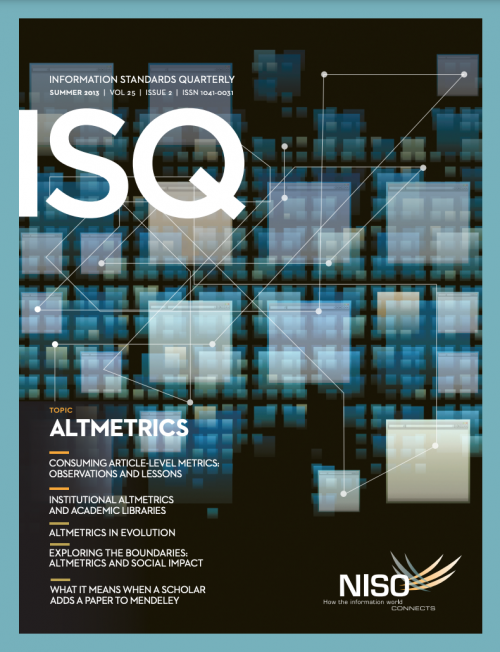Information Standards Quarterly, Summer 2013
Letter from the Editor
The idea of using the social web—social bookmarks, tweets, Facebook "likes", Wikipedia references, etc.—to track the post-publication discussion around journal articles and other scholarly content is of course older, but in 2010 both the term altmetrics was coined (https://twitter.com/jasonpriem/ status/25844968813) and a widely-read manifesto published (altmetrics.org/manifesto/).
Since then, we have seen a flurry of activity around altmetrics, including numerous articles and blog posts, three conferences— altmetrics11 (altmetrics.org/ workshop2011/ ), altmetrics12 (altmetrics.org/altmetrics12/), and ALM Workshop 2012 (article-level-metrics.plos.org/ alm-workshop-2012/), plenty of conference presentations, a growing number of publishers displaying altmetrics with their articles, and the launch of at least three organizations dedicated to collecting and providing altmetrics. The discussion around altmetrics has shifted accordingly. We no longer need to talk about whether it is possible to reliably collect altmetrics, or whether this is valuable information that can complement citations and usage statistics.
Altmetrics have grown up, and the articles on altmetrics in this issue of ISQ reflect this shift in the discussion. The two feature articles look at emerging best practices and commonalities in this burgeoning field. Scott Chamberlain compares altmetrics data from four different altmetrics services for the same set of articles. Robin Chin Roemer and Rachel Borchardt remind us that altmetrics so far have focused on single articles or the research outputs of individual researchers and that we need to also make this information available in a format that works for institutions with their much larger sets of research outputs. Three in- practice articles review specific tools or practices that are underway. Jennifer Lin and I discuss how PLOS is taking altmetrics, a diverse group of metrics that basically include everything that is not a traditional citation or usage stats, and grouping them according to similarities to provide additional insights. Mike Taylor explains how altmetrics can help us with understanding the broader social impact of research. And William Gunn details how Mendeley, a social reference manager that makes the bookmarking activity of its users available via an open API, can be used for altmetrics. We also report on a new NISO initiative, with funding from the Sloan Foundation, to gather input from the community and then develop needed standards and recommended practices for altmetrics. Many of the articles in this issue discuss the areas where such standards are needed, so the launching of this project is well timed.
Coming of age sometimes means becoming dull and boring. I hope that the altmetrics articles in this issue convince you that nothing could be farther from the truth. There is a lot of interesting reading in these articles, and they all bring new and sometimes unexpected perspectives to the discussion. The same is true for the field of altmetrics itself. Growing up doesn’t at all mean we should stop research and experimentation. Much more work is needed, for example, on metrics for research outputs that are not journal articles (e.g., monographs or datasets), additional altmetrics sources, and on anti-gaming strategies.
This issue of Information Standards Quarterly should provide much food for thought and further experiments as the field of altmetrics progresses.

Table of Contents
Features
In Practice
NISO Reports
Noteworthy
State of the Standards
Front Matter
Publication Date:
Volume/Issue: 25/2
DOI: https://doi.org/10.3789/isqv25no2.2013
ISSN: 1041-0031